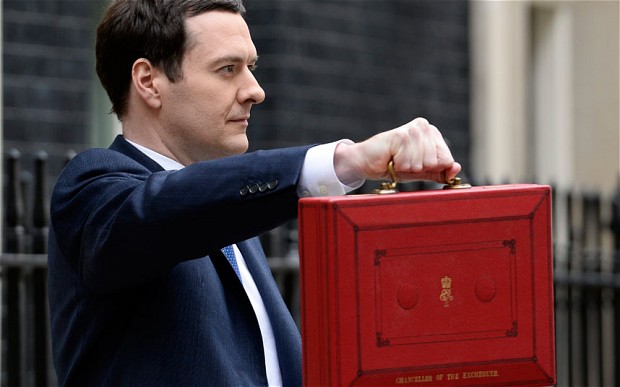10p tax: how it could put £760 a year in savers’ pockets
We explain how to benefit from a new perk announced in the Budget which could put an extra £760 a year in savers’ pockets 
Photo: EPA
A new tax break announced in the Budget could put an extra £760 a year in savers’ pockets – but only if they reclaim the money from the taxman.
The Chancellor said he would introduce a special tax-exempt band of income just for savers. Currently, savers with modest incomes from other sources can benefit from a 10pc tax band, but millions fail to claim, needlessly paying more tax than they should.
This is partly because the tax break is hard to understand. Unlike the personal allowance, the 10pc rate applies only to savings income, and is not available at all if you have a decent income from other sources. Another problem is the need to complete a claim form rather than having the correct tax deducted automatically.
Here we explain in more detail how the new tax band will work and how to ensure that you don’t miss out. We also detail how you can claim up to four years’ worth of overpaid tax if you previously failed to benefit from the 10pc rate.
The current tax breaks for savers
Thanks to a little-known perk, some savers can already pay a reduced rate of tax on a portion of their income from savings. The first £2,790 in savings interest is taxed at a reduced rate of 10pc, compared with the normal basic rate of 20pc applied to any savings income above this level.
The tax break applies only to people with modest incomes. To benefit from the full £2,790 10pc band, your income from other sources, such as salary, pensions or rent, cannot exceed the personal allowance, currently £9,440 but rising to £10,000 with the new tax year on April 6.
Once your other income rises above this level the 10pc tax band gets progressively smaller until, when your total income from other sources reaches £12,230 (£9,440 plus £2,790), it disappears altogether.
Frustratingly for those savers eligible for the tax break, you cannot have the correct tax deducted at source by your bank or building society (although anyone who is entitled to have interest paid completely tax-free can receive it gross by submitting HMRC form R85 to their bank).
Instead, savers have to fill in one of two forms every year if they want to claim the reduced rate of tax.
As a result, millions of people fail to benefit from the tax break. According to HM Revenue & Customs, only 15pc of taxpayers eligible for the 10pc savings rate actually take advantage of it.
“The number of taxpayers in 2011‑12 with savings income in the 10pc band is estimated to have been around 3.6 million,” a spokesman said. “Of these, around 540,000 [15pc] claimed back the difference between tax on interest deducted at source and tax liable at the 10pc starting rate.”
Interest on savings held in Isas is automatically tax-free and can be disregarded when you calculate how much of your savings income is eligible for the 10pc rate.
The new tax break
From April next year, the special rate of tax on savings will be cut from 10pc to zero and the band of income to which it applies will rise to £5,000. So, provided that your other income is modest, the first £5,000 of savings income can be tax-free.
Again, the tax break applies in full only if your income from other sources does not exceed the personal allowance. It will be withdrawn gradually until, when your other income reaches £5,000 more than the personal allowance, you will not benefit at all.
How much you can save
You can save as much as £762 a year from the new 0pc rate on savings. This figure applies to someone who has £5,000 of savings income on top of £10,500 from other sources.
In the tax year that begins next month, before the changes take effect, this saver will face a total income tax bill of £862, according to Suzy Levett of Grant Thornton (pictured), the accountancy firm. But in the following tax year, after the 0pc band comes in, the tax bill will fall to zero.
The calculation is complicated by the fact that the personal allowance is different for the two years, but Ms Levett said £762 of the tax saving was down to the 0pc rate and just £100 resulted from the rise in the personal allowance.
However, any extra income from other sources will erode the new tax-free band. Imagine that you had pension income of £12,500 and savings income of £5,000.
Next tax year, before the new 0pc band comes in, your total tax bill would be £1,462, Ms Levett calculated. In the following year, after the tax-free band takes effect, you would pay £800 in tax, a saving of £662.
How to benefit from the new tax break
The new 0pc tax break isn’t just more generous than the previous perk, it will also be easier to claim.
Anyone who knows that all their interest from a particular bank or building society will not be subject to tax can ask to have it paid gross by filling in form R85. This was not possible when the preferential rate on savings was 10pc because banks had no means of making a partial deduction.
Alternatively, you will still be able to reclaim overpaid tax by submitting form R40 to HMRC or by filing a self-assessment tax return.
How to claim overpaid tax from previous years
Because you are allowed to reclaim overpaid tax dating back four years, savers who are eligible for the 10pc rate but failed to claim it could be entitled to up to £976 for the years from April 6 2009 to April 5 2013.
If you apply by April 5 this year, that is a maximum of £271 for the 2012-13 tax year, £256 for 2011-12, £244 for 2010-11 and £244 for 2009-10. Then, from April 6, you’ll be able to claim £279 for the 2013-14 tax year. This gives a total of £1,294.
You will need form R40 from HMRC – one for each year for which you want to claim. You can get the form by downloading it from hmrc.gov.uk/forms/r40.pdf or by calling HMRC on 0300 200 3300 .
